Health Promotion Strategies for African Americans in the US
VerifiedAdded on 2022/09/28
|5
|1339
|26
Essay
AI Summary
This paper examines the health status of African Americans in the US, highlighting the disparities they face due to historical and ongoing social and racial inequalities. It discusses how factors like racism, poor housing, and poverty contribute to higher rates of chronic diseases and mortality in this community. The essay emphasizes the importance of culturally competent health promotion strategies, such as health fairs, to address these disparities. It suggests integrating the cultural knowledge model to understand the community's beliefs about health and disease management, ultimately aiming to improve the health outcomes of African Americans through targeted interventions and education.
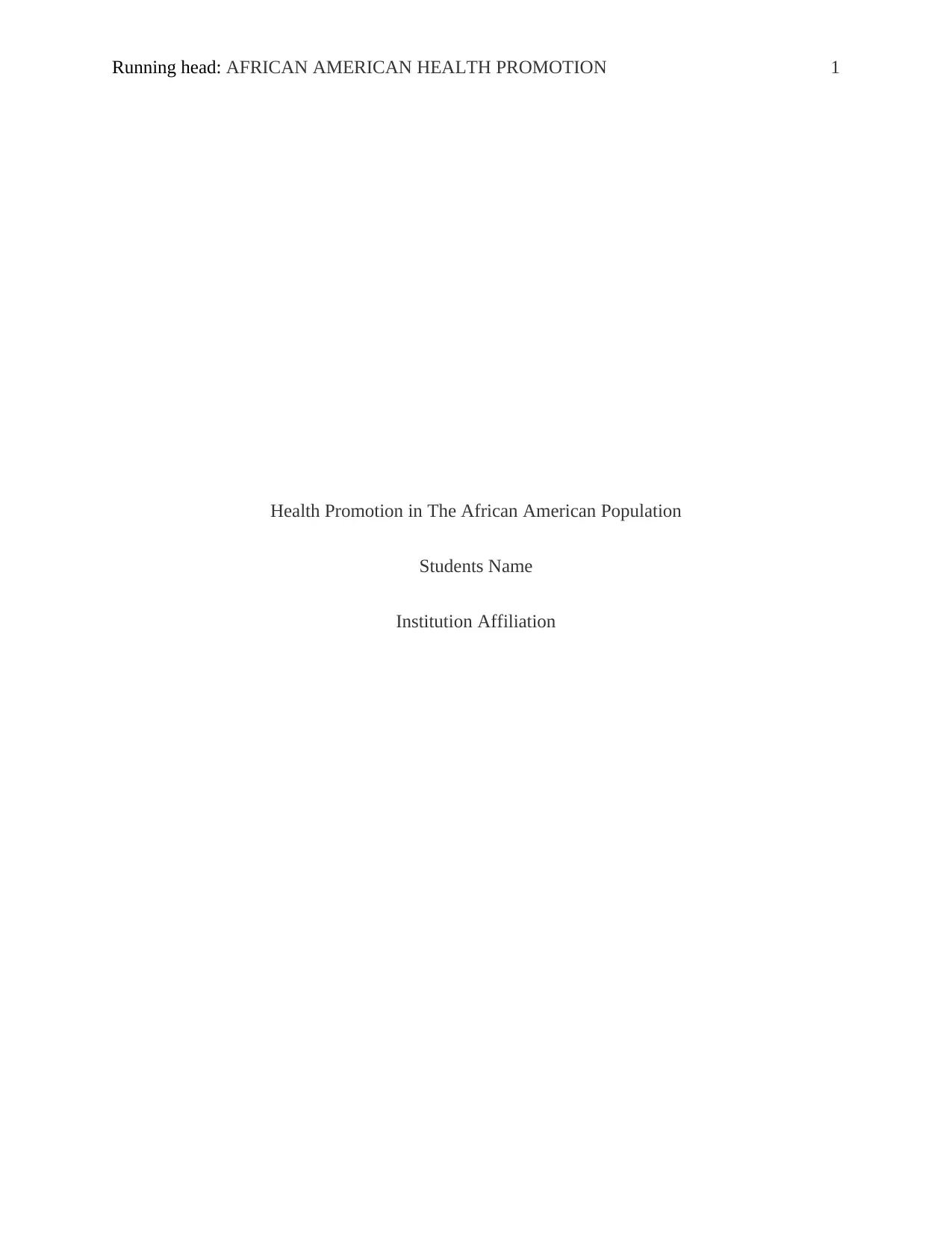
Running head: AFRICAN AMERICAN HEALTH PROMOTION 1
Health Promotion in The African American Population
Students Name
Institution Affiliation
Health Promotion in The African American Population
Students Name
Institution Affiliation
Paraphrase This Document
Need a fresh take? Get an instant paraphrase of this document with our AI Paraphraser
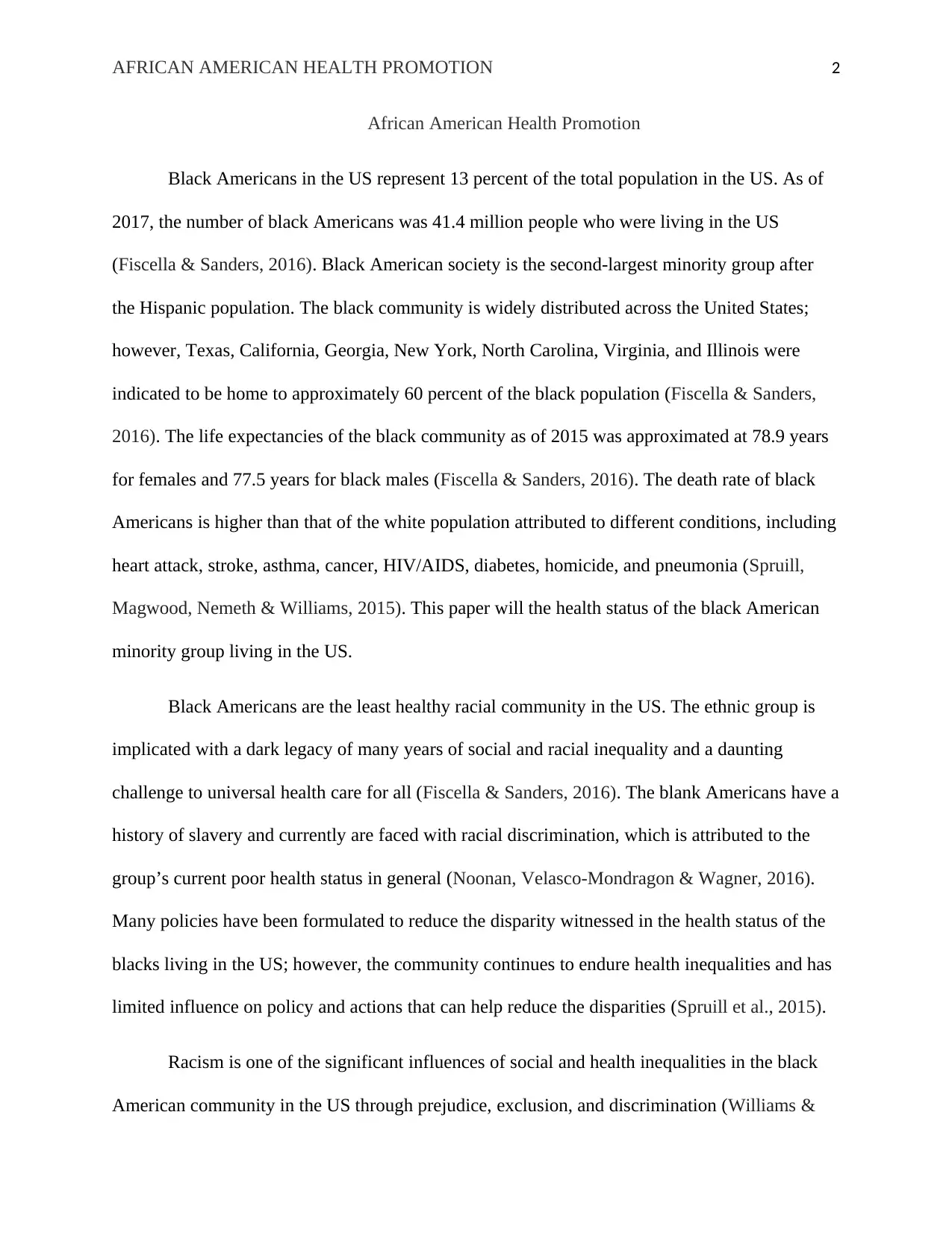
AFRICAN AMERICAN HEALTH PROMOTION 2
African American Health Promotion
Black Americans in the US represent 13 percent of the total population in the US. As of
2017, the number of black Americans was 41.4 million people who were living in the US
(Fiscella & Sanders, 2016). Black American society is the second-largest minority group after
the Hispanic population. The black community is widely distributed across the United States;
however, Texas, California, Georgia, New York, North Carolina, Virginia, and Illinois were
indicated to be home to approximately 60 percent of the black population (Fiscella & Sanders,
2016). The life expectancies of the black community as of 2015 was approximated at 78.9 years
for females and 77.5 years for black males (Fiscella & Sanders, 2016). The death rate of black
Americans is higher than that of the white population attributed to different conditions, including
heart attack, stroke, asthma, cancer, HIV/AIDS, diabetes, homicide, and pneumonia (Spruill,
Magwood, Nemeth & Williams, 2015). This paper will the health status of the black American
minority group living in the US.
Black Americans are the least healthy racial community in the US. The ethnic group is
implicated with a dark legacy of many years of social and racial inequality and a daunting
challenge to universal health care for all (Fiscella & Sanders, 2016). The blank Americans have a
history of slavery and currently are faced with racial discrimination, which is attributed to the
group’s current poor health status in general (Noonan, Velasco-Mondragon & Wagner, 2016).
Many policies have been formulated to reduce the disparity witnessed in the health status of the
blacks living in the US; however, the community continues to endure health inequalities and has
limited influence on policy and actions that can help reduce the disparities (Spruill et al., 2015).
Racism is one of the significant influences of social and health inequalities in the black
American community in the US through prejudice, exclusion, and discrimination (Williams &
African American Health Promotion
Black Americans in the US represent 13 percent of the total population in the US. As of
2017, the number of black Americans was 41.4 million people who were living in the US
(Fiscella & Sanders, 2016). Black American society is the second-largest minority group after
the Hispanic population. The black community is widely distributed across the United States;
however, Texas, California, Georgia, New York, North Carolina, Virginia, and Illinois were
indicated to be home to approximately 60 percent of the black population (Fiscella & Sanders,
2016). The life expectancies of the black community as of 2015 was approximated at 78.9 years
for females and 77.5 years for black males (Fiscella & Sanders, 2016). The death rate of black
Americans is higher than that of the white population attributed to different conditions, including
heart attack, stroke, asthma, cancer, HIV/AIDS, diabetes, homicide, and pneumonia (Spruill,
Magwood, Nemeth & Williams, 2015). This paper will the health status of the black American
minority group living in the US.
Black Americans are the least healthy racial community in the US. The ethnic group is
implicated with a dark legacy of many years of social and racial inequality and a daunting
challenge to universal health care for all (Fiscella & Sanders, 2016). The blank Americans have a
history of slavery and currently are faced with racial discrimination, which is attributed to the
group’s current poor health status in general (Noonan, Velasco-Mondragon & Wagner, 2016).
Many policies have been formulated to reduce the disparity witnessed in the health status of the
blacks living in the US; however, the community continues to endure health inequalities and has
limited influence on policy and actions that can help reduce the disparities (Spruill et al., 2015).
Racism is one of the significant influences of social and health inequalities in the black
American community in the US through prejudice, exclusion, and discrimination (Williams &
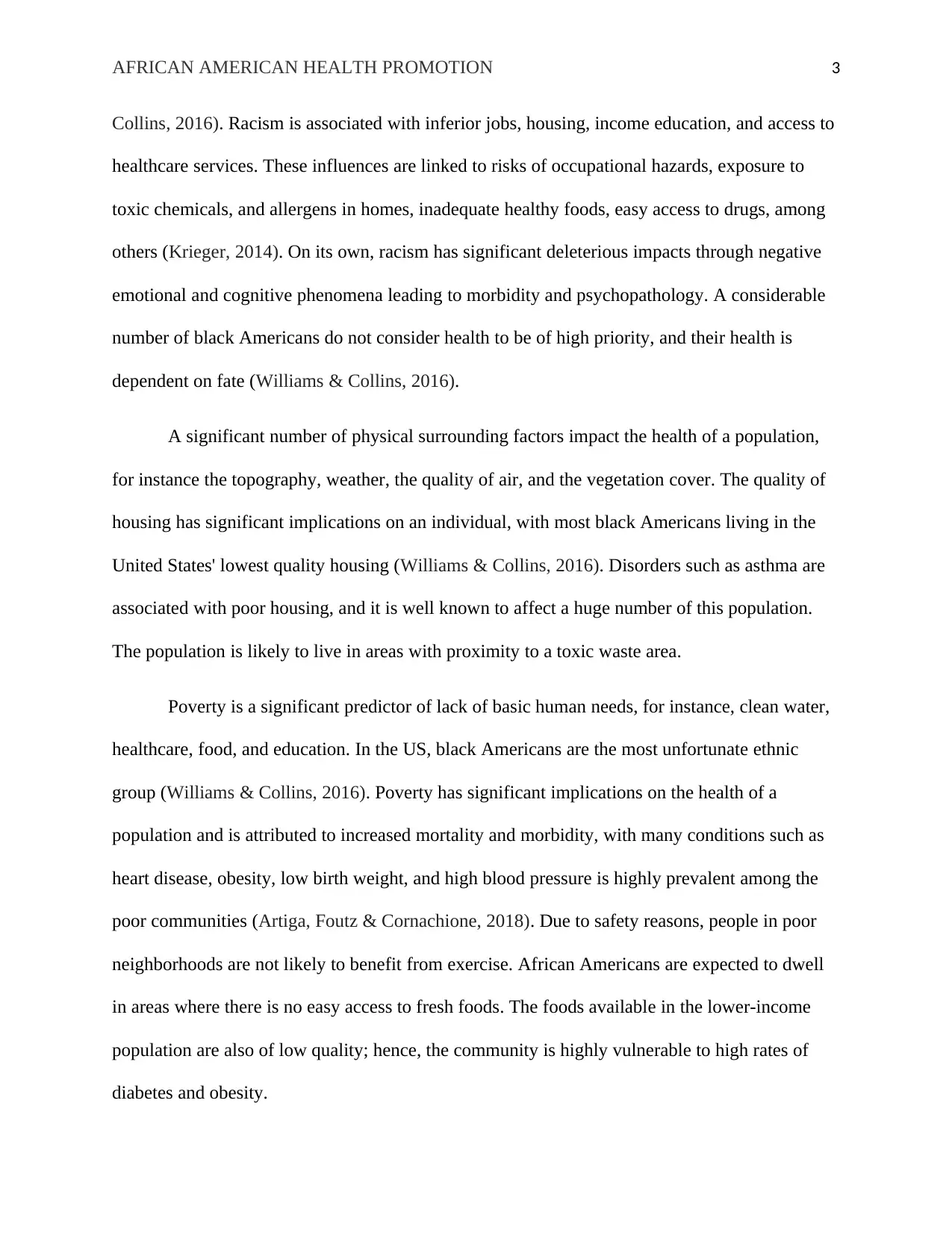
AFRICAN AMERICAN HEALTH PROMOTION 3
Collins, 2016). Racism is associated with inferior jobs, housing, income education, and access to
healthcare services. These influences are linked to risks of occupational hazards, exposure to
toxic chemicals, and allergens in homes, inadequate healthy foods, easy access to drugs, among
others (Krieger, 2014). On its own, racism has significant deleterious impacts through negative
emotional and cognitive phenomena leading to morbidity and psychopathology. A considerable
number of black Americans do not consider health to be of high priority, and their health is
dependent on fate (Williams & Collins, 2016).
A significant number of physical surrounding factors impact the health of a population,
for instance the topography, weather, the quality of air, and the vegetation cover. The quality of
housing has significant implications on an individual, with most black Americans living in the
United States' lowest quality housing (Williams & Collins, 2016). Disorders such as asthma are
associated with poor housing, and it is well known to affect a huge number of this population.
The population is likely to live in areas with proximity to a toxic waste area.
Poverty is a significant predictor of lack of basic human needs, for instance, clean water,
healthcare, food, and education. In the US, black Americans are the most unfortunate ethnic
group (Williams & Collins, 2016). Poverty has significant implications on the health of a
population and is attributed to increased mortality and morbidity, with many conditions such as
heart disease, obesity, low birth weight, and high blood pressure is highly prevalent among the
poor communities (Artiga, Foutz & Cornachione, 2018). Due to safety reasons, people in poor
neighborhoods are not likely to benefit from exercise. African Americans are expected to dwell
in areas where there is no easy access to fresh foods. The foods available in the lower-income
population are also of low quality; hence, the community is highly vulnerable to high rates of
diabetes and obesity.
Collins, 2016). Racism is associated with inferior jobs, housing, income education, and access to
healthcare services. These influences are linked to risks of occupational hazards, exposure to
toxic chemicals, and allergens in homes, inadequate healthy foods, easy access to drugs, among
others (Krieger, 2014). On its own, racism has significant deleterious impacts through negative
emotional and cognitive phenomena leading to morbidity and psychopathology. A considerable
number of black Americans do not consider health to be of high priority, and their health is
dependent on fate (Williams & Collins, 2016).
A significant number of physical surrounding factors impact the health of a population,
for instance the topography, weather, the quality of air, and the vegetation cover. The quality of
housing has significant implications on an individual, with most black Americans living in the
United States' lowest quality housing (Williams & Collins, 2016). Disorders such as asthma are
associated with poor housing, and it is well known to affect a huge number of this population.
The population is likely to live in areas with proximity to a toxic waste area.
Poverty is a significant predictor of lack of basic human needs, for instance, clean water,
healthcare, food, and education. In the US, black Americans are the most unfortunate ethnic
group (Williams & Collins, 2016). Poverty has significant implications on the health of a
population and is attributed to increased mortality and morbidity, with many conditions such as
heart disease, obesity, low birth weight, and high blood pressure is highly prevalent among the
poor communities (Artiga, Foutz & Cornachione, 2018). Due to safety reasons, people in poor
neighborhoods are not likely to benefit from exercise. African Americans are expected to dwell
in areas where there is no easy access to fresh foods. The foods available in the lower-income
population are also of low quality; hence, the community is highly vulnerable to high rates of
diabetes and obesity.
⊘ This is a preview!⊘
Do you want full access?
Subscribe today to unlock all pages.

Trusted by 1+ million students worldwide
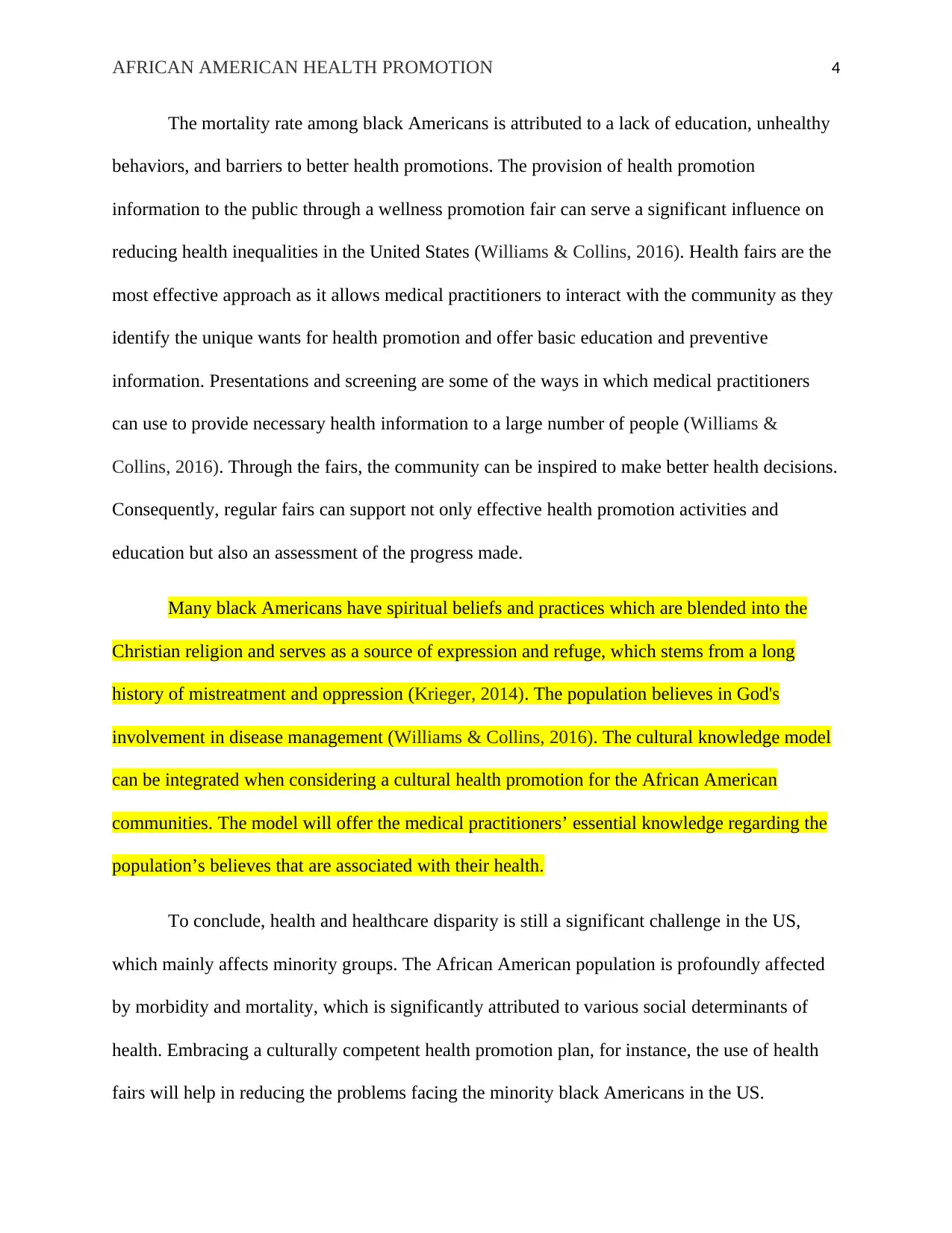
AFRICAN AMERICAN HEALTH PROMOTION 4
The mortality rate among black Americans is attributed to a lack of education, unhealthy
behaviors, and barriers to better health promotions. The provision of health promotion
information to the public through a wellness promotion fair can serve a significant influence on
reducing health inequalities in the United States (Williams & Collins, 2016). Health fairs are the
most effective approach as it allows medical practitioners to interact with the community as they
identify the unique wants for health promotion and offer basic education and preventive
information. Presentations and screening are some of the ways in which medical practitioners
can use to provide necessary health information to a large number of people (Williams &
Collins, 2016). Through the fairs, the community can be inspired to make better health decisions.
Consequently, regular fairs can support not only effective health promotion activities and
education but also an assessment of the progress made.
Many black Americans have spiritual beliefs and practices which are blended into the
Christian religion and serves as a source of expression and refuge, which stems from a long
history of mistreatment and oppression (Krieger, 2014). The population believes in God's
involvement in disease management (Williams & Collins, 2016). The cultural knowledge model
can be integrated when considering a cultural health promotion for the African American
communities. The model will offer the medical practitioners’ essential knowledge regarding the
population’s believes that are associated with their health.
To conclude, health and healthcare disparity is still a significant challenge in the US,
which mainly affects minority groups. The African American population is profoundly affected
by morbidity and mortality, which is significantly attributed to various social determinants of
health. Embracing a culturally competent health promotion plan, for instance, the use of health
fairs will help in reducing the problems facing the minority black Americans in the US.
The mortality rate among black Americans is attributed to a lack of education, unhealthy
behaviors, and barriers to better health promotions. The provision of health promotion
information to the public through a wellness promotion fair can serve a significant influence on
reducing health inequalities in the United States (Williams & Collins, 2016). Health fairs are the
most effective approach as it allows medical practitioners to interact with the community as they
identify the unique wants for health promotion and offer basic education and preventive
information. Presentations and screening are some of the ways in which medical practitioners
can use to provide necessary health information to a large number of people (Williams &
Collins, 2016). Through the fairs, the community can be inspired to make better health decisions.
Consequently, regular fairs can support not only effective health promotion activities and
education but also an assessment of the progress made.
Many black Americans have spiritual beliefs and practices which are blended into the
Christian religion and serves as a source of expression and refuge, which stems from a long
history of mistreatment and oppression (Krieger, 2014). The population believes in God's
involvement in disease management (Williams & Collins, 2016). The cultural knowledge model
can be integrated when considering a cultural health promotion for the African American
communities. The model will offer the medical practitioners’ essential knowledge regarding the
population’s believes that are associated with their health.
To conclude, health and healthcare disparity is still a significant challenge in the US,
which mainly affects minority groups. The African American population is profoundly affected
by morbidity and mortality, which is significantly attributed to various social determinants of
health. Embracing a culturally competent health promotion plan, for instance, the use of health
fairs will help in reducing the problems facing the minority black Americans in the US.
Paraphrase This Document
Need a fresh take? Get an instant paraphrase of this document with our AI Paraphraser
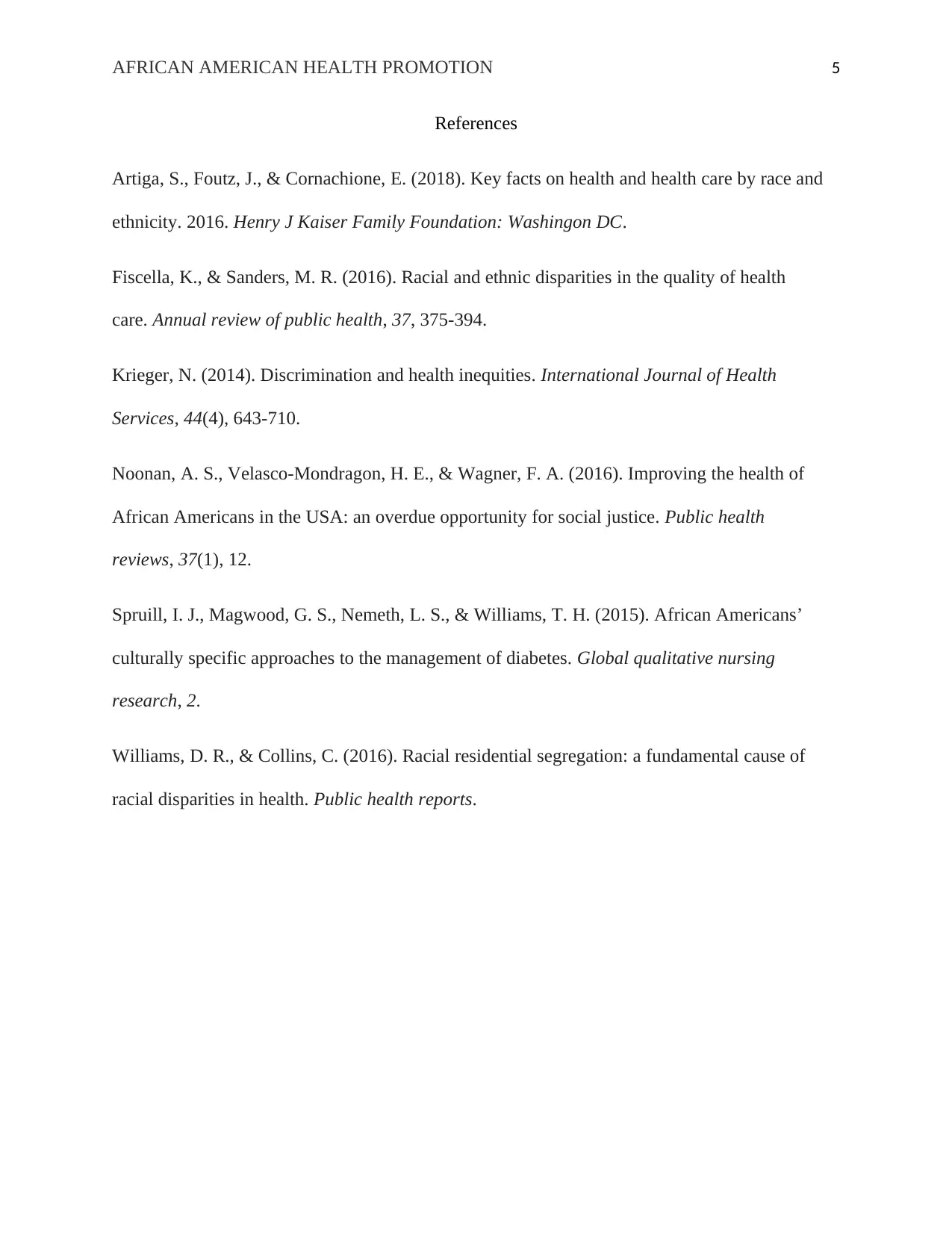
AFRICAN AMERICAN HEALTH PROMOTION 5
References
Artiga, S., Foutz, J., & Cornachione, E. (2018). Key facts on health and health care by race and
ethnicity. 2016. Henry J Kaiser Family Foundation: Washingon DC.
Fiscella, K., & Sanders, M. R. (2016). Racial and ethnic disparities in the quality of health
care. Annual review of public health, 37, 375-394.
Krieger, N. (2014). Discrimination and health inequities. International Journal of Health
Services, 44(4), 643-710.
Noonan, A. S., Velasco-Mondragon, H. E., & Wagner, F. A. (2016). Improving the health of
African Americans in the USA: an overdue opportunity for social justice. Public health
reviews, 37(1), 12.
Spruill, I. J., Magwood, G. S., Nemeth, L. S., & Williams, T. H. (2015). African Americans’
culturally specific approaches to the management of diabetes. Global qualitative nursing
research, 2.
Williams, D. R., & Collins, C. (2016). Racial residential segregation: a fundamental cause of
racial disparities in health. Public health reports.
References
Artiga, S., Foutz, J., & Cornachione, E. (2018). Key facts on health and health care by race and
ethnicity. 2016. Henry J Kaiser Family Foundation: Washingon DC.
Fiscella, K., & Sanders, M. R. (2016). Racial and ethnic disparities in the quality of health
care. Annual review of public health, 37, 375-394.
Krieger, N. (2014). Discrimination and health inequities. International Journal of Health
Services, 44(4), 643-710.
Noonan, A. S., Velasco-Mondragon, H. E., & Wagner, F. A. (2016). Improving the health of
African Americans in the USA: an overdue opportunity for social justice. Public health
reviews, 37(1), 12.
Spruill, I. J., Magwood, G. S., Nemeth, L. S., & Williams, T. H. (2015). African Americans’
culturally specific approaches to the management of diabetes. Global qualitative nursing
research, 2.
Williams, D. R., & Collins, C. (2016). Racial residential segregation: a fundamental cause of
racial disparities in health. Public health reports.
1 out of 5
Related Documents
Your All-in-One AI-Powered Toolkit for Academic Success.
+13062052269
info@desklib.com
Available 24*7 on WhatsApp / Email
![[object Object]](/_next/static/media/star-bottom.7253800d.svg)
Unlock your academic potential
Copyright © 2020–2025 A2Z Services. All Rights Reserved. Developed and managed by ZUCOL.





